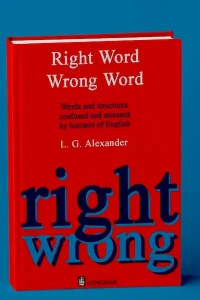The right word wrong word longman is a reference and practice book of words and structures often confused or misused by learners. It is aimed at intermediate students and above in the upper secondary to adult age range.
What is Right Word Wrong Word?
Right Word Wrong Word is a Reference and Practice Book based on common errors in English. It covers items like the following:
- Words often confused, where the student’s native language interferes with English (false friends): for example, benzine/petrol.
- Word-confusions that exist within English itself: for example, rob/steal/burgle.
- Structures in the student% language that interfere with English structures: for example, it has compared with there is/it is.
- Confusions of structures within English itself: for example, must/had to.
- Particular words and structures which are a well-known source of error: for example, get and enjoy.
Right Word Wrong Word is therefore a comprehensive usage book that provides answers to students’ questions that are not easily available from any other source.
Who is the book for?
The book is suitable for students of English as a foreign or second language at intermediate level and above, whether they are preparing for examinations or not. It is also suitable for teachers.
It extends the knowledge of non-native teachers by clarifying the meanings and uses of related items; it sensitizes native-speaking teachers by making them aware of mistakes that students really make. For both kinds of teachers, it is a handy reference for dealing with awkward questions on the spot.
How to use Right Word Wrong Word?
Index
If you are in doubt about the use of a word, look in the index to find it, then go to the reference section. You may have to do this more than once to locate the meaning you are looking for. When you find the word you want, check whether the mistake listed is one you are likely to make yourself and which you must train yourself to suppress.
The reference section
The ‘wrong word’ is generally listed first, followed by the ‘right word’. For example:
block * pad
- I’ve brought this nice new pad to take notes during the meeting. (Not *block*) (pad/writing pad = sheets of paper held together, used for writing or drawing).
- – How did the ancient Egyptians cut and move such huge stone blocks ? (= stone, wood, etc., cut with straight sides).
Some words appear in different places. For example, mark has its own entry, but is also listed under grade/mark/degree, note down/mark and speck/spot/mark. The reference section focuses sharply on particular problems of contrast or use. It is not a dictionary and so does not deal with every possible meaning of a particular word.
Technical terms
The terms used in the reference section are briefly explained on pages 289-290.
Test Yourself
Exercises 1-41 are suitable for students of all levels, but especially for intermediate; exercises 42-96 are upper intermediate and advanced. The exercises deal with topics (e.g. health), functions (e.g. doing things for people), or grammar (e.g. phrasal verbs). You may work through the exercises in the order they occur, or pick and choose, according to level.
- Attempt an exercise, then check your answers in the answer key.
- Look up any item or items you aren’t sure of in the index, which will refer you to the reference section.
Practise using the items you have learned in your own speech and writing.


